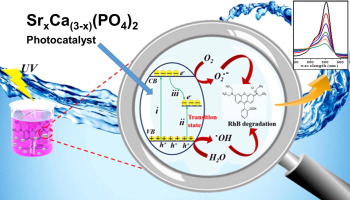当前位置:
X-MOL 学术
›
J. Colloid Interface Sci.
›
论文详情
Our official English website, www.x-mol.net, welcomes your
feedback! (Note: you will need to create a separate account there.)
Influence of Sr-doping on structural, optical and photocatalytic properties of synthesized Ca3(PO4)2.
Journal of Colloid and Interface Science ( IF 9.4 ) Pub Date : 2020-03-29 , DOI: 10.1016/j.jcis.2020.03.105 Y Naciri 1 , A Hsini 1 , Z Ajmal 2 , A Bouddouch 3 , B Bakiz 1 , J A Navío 4 , A Albourine 1 , J-C Valmalette 5 , M Ezahri 1 , A Benlhachemi 1
Journal of Colloid and Interface Science ( IF 9.4 ) Pub Date : 2020-03-29 , DOI: 10.1016/j.jcis.2020.03.105 Y Naciri 1 , A Hsini 1 , Z Ajmal 2 , A Bouddouch 3 , B Bakiz 1 , J A Navío 4 , A Albourine 1 , J-C Valmalette 5 , M Ezahri 1 , A Benlhachemi 1
Affiliation

|
Well-crystallized Ca3(PO4)2 doped and un-doped nano-particles with the maximum strontium content (40 wt% Sr) followed by calcination at 800 °C for 3 h were synthesized via facile co-precipitation method. DTA/TGA, X-ray diffraction (XRD), energy dispersive scanning electron microscopy (SEM/EDX), UV-vis diffuse reflectance spectrum (UV-vis DRS), Raman spectroscopy and photoluminescence (PL) techniques were used for material characterization. The (XRD) patterns of as-synthesized Sr-doped Ca3(PO4)2 solid solution samples exhibited a systematic shift toward lower angles by possessing a single rhombohedral crystal structure without any secondary phases. The UV light driven photocatalytic activity was assessed for rhodamine B (RhB) degradation. As a result, ultrafast photodegradation activity was observed after Sr doping. Moreover, the 30 wt% Sr-Ca3(PO4)2 sample showed the highest photocatalytic degradation among the Sr-doped Ca3(PO4)2 samples toward RhB. It was further suggested that as-synthesized 30 wt% Sr-Ca3(PO4)2 superior photocatalytic performance is ascribed to the more proficient partition of photogenerated electron-hole pairs. Furthermore, the involved mechanism of superior photocatalytic performance of the 30 wt% Sr-Ca3(PO4)2 solid solution was also investigated. In addition, regeneration cycles indicated the higher stability of the photocatalyst to be effectively recycled up to four times without any considerable reduction in photocatalytic performance. Thus, these informations further provides us a scalable pathway to fabricate Sr doped Ca3(PO4)2 and its consequent use as an efficient photocatalyst for rhodamine B (RhB) contaminated wastewater treatment.
中文翻译:

Sr掺杂对合成Ca3(PO4)2的结构,光学和光催化性能的影响。
通过简单的共沉淀法合成了具有最大锶含量(40 wt%Sr),然后在800°C下煅烧3 h的结晶良好的Ca3(PO4)2掺杂和未掺杂纳米粒子。DTA / TGA,X射线衍射(XRD),能量色散扫描电子显微镜(SEM / EDX),紫外可见漫反射光谱(UV-vis DRS),拉曼光谱和光致发光(PL)技术用于材料表征。刚合成的掺Sr的Ca3(PO4)2固溶体样品的(XRD)图案通过拥有单个菱形的晶体结构而没有任何次级相而表现出向较低角度的系统性转变。评估了紫外光驱动的罗丹明B(RhB)降解的光催化活性。结果,在Sr掺杂之后观察到超快的光降解活性。此外,30 wt%Sr-Ca3(PO4)2样品在掺Sr的Ca3(PO4)2样品中对RhB表现出最高的光催化降解。进一步表明,合成后的30 wt%Sr-Ca3(PO4)2优异的光催化性能归因于光生电子-空穴对的更有效分配。此外,还研究了所涉及的30 wt%Sr-Ca3(PO4)2固溶体具有优异的光催化性能的机理。另外,再生循环表明光催化剂的较高稳定性可以有效地循环多达四次,而光催化性能没有任何显着降低。因此,这些信息进一步为我们提供了一种可扩展的途径来制备掺Sr的Ca3(PO4)2,并将其作为有效的光催化剂用于罗丹明B(RhB)污染的废水处理。
更新日期:2020-03-31
中文翻译:

Sr掺杂对合成Ca3(PO4)2的结构,光学和光催化性能的影响。
通过简单的共沉淀法合成了具有最大锶含量(40 wt%Sr),然后在800°C下煅烧3 h的结晶良好的Ca3(PO4)2掺杂和未掺杂纳米粒子。DTA / TGA,X射线衍射(XRD),能量色散扫描电子显微镜(SEM / EDX),紫外可见漫反射光谱(UV-vis DRS),拉曼光谱和光致发光(PL)技术用于材料表征。刚合成的掺Sr的Ca3(PO4)2固溶体样品的(XRD)图案通过拥有单个菱形的晶体结构而没有任何次级相而表现出向较低角度的系统性转变。评估了紫外光驱动的罗丹明B(RhB)降解的光催化活性。结果,在Sr掺杂之后观察到超快的光降解活性。此外,30 wt%Sr-Ca3(PO4)2样品在掺Sr的Ca3(PO4)2样品中对RhB表现出最高的光催化降解。进一步表明,合成后的30 wt%Sr-Ca3(PO4)2优异的光催化性能归因于光生电子-空穴对的更有效分配。此外,还研究了所涉及的30 wt%Sr-Ca3(PO4)2固溶体具有优异的光催化性能的机理。另外,再生循环表明光催化剂的较高稳定性可以有效地循环多达四次,而光催化性能没有任何显着降低。因此,这些信息进一步为我们提供了一种可扩展的途径来制备掺Sr的Ca3(PO4)2,并将其作为有效的光催化剂用于罗丹明B(RhB)污染的废水处理。











































 京公网安备 11010802027423号
京公网安备 11010802027423号